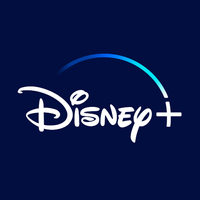Why Rogue One is the most underrated Star Wars movie in the galaxy
Cassian Andor's tragic debut isn't just the best 'Disney era' Star Wars movie, it holds its own against George Lucas’ sacred Original Trilogy too.

When Rogue One: A Star Wars Story released in December 2016 it was a simpler time. The Force Awakens had predictably smashed box office records the year prior, Colin Trevorrow was still set to direct Star Wars Episode IX, and Phil Lord and Chris Miller were about to start filming their own anthology movie Solo: A Star Wars Story. Disney was on top of the galaxy and with so many potential movie rumors floating around, something akin to a Star Wars Cinematic Universe looked all but a certainty.
Star Wars has famously struggled to find a footing in China and despite the inclusion of Hong Kong megastar Donnie Yen and Chinese co-star Jiang Wen, Rogue One was no different. However, its worldwide box office takings have now exceeded $1 billion and it enjoyed favorable reviews upon release. But a year later and The Last Jedi would cleave the Star Wars fandom in two, and 2018's Solo failed to entice even domestic audiences to cinemas.
Today, following a disappointing conclusion to the Skywalker Saga, the immediate future of Star Wars movies is somewhat ambiguous with Patty Jenkins’ Rogue Squadron sadly the latest casualty. Instead, the House of Mouse has focused its efforts on a seemingly infinite roster of upcoming Star Wars TV shows.
But as Andor begins to gather steam, the movie that inspired Star Wars latest small-screen release has risen above the soap-opera-like rumor mill and malaise of feuding fans. Rogue One is enjoying another moment in the spotlight and it’s a reminder that Disney not only got a Star Wars movie right, it released one of the best Star Wars movies ever. So once you’ve delved into our Star Wars movies ranked, worst to best listicle, read on to find out why…
Watch Rogue One & Andor on Disney+: $7.99/month or $79.99/year
Sign up to Disney+ to watch Rogue One & Andor to see Cassian's full story, along with a host of other Star Wars content.

Before The Mandalorian, you’d have to look to Jyn and Cassian for proof that force-powerless characters can make compelling protagonists. And while Star Wars’ first female lead, Rey, has drawn criticism for her muddled backstory and lack of growth, Jyn is an extremely relatable character with believable motives and a tragic backstory that’s perhaps only rivalled by Anakin Skywalker.
Cassian was popular enough to spawn his own television series and it’s easy to see why. He’s cut from the same cloth as loveable rogue Han Solo and what must surely be a clever nod to the Star Wars stalwart, we’re introduced to Cassian’s morally grey disposition almost immediately.
You see, in the theatrical release of Star Wars (1977) Han Solo famously shot the bounty hunter Greedo in the Mos Eisley Cantina. However, George Lucas changed this for the infamous 1997 Star Wars Trilogy Special Edition so that Greedo fired the first shot and Han was no longer a cold-blooded killer. Rogue One director Gareth Edwards obviously didn’t have the same misgivings when it came to Cassian though, who shoots an informant dead minutes after appearing on-screen. And to think some fans were worried Disney would seek to pacify a galaxy far, far away…
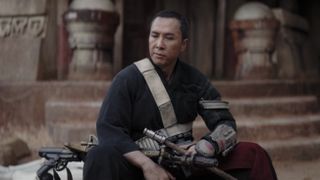
Rogue One also boasts one of the most diverse Star Wars casts ever and is all the better for it. Donnie Yen’s blind warrior-monk Chirrut Îmwe quickly cemented himself as a fan favorite alongside his strong-silent-type partner Baze Malbus (Jiang Wen). Riz Ahmed rounds off the Rogues with imperial-pilot defector Bodhi Rook. Side characters Saw Gerrera and Galen Erso deserve a mention too, with Forest Whitaker’s unhinged extremist stealing every one of his few scenes and the ever-popular Mads Mikkelsen's convincing portrayal of a talented scientist who fell in with the wrong crowd.
Director Orson Krennic (Ben Mendelsohn), is Rogue One’s main antagonist and an inviting change from angsty Sith Lords. His striking white attire and cape convey his penchant for the theatrical, while his childlike need to impress and obsessive ambition, result in temper tantrums when his superiors ignore or take credit for his achievements.
Like a true heel, Krennic is a character you love to hate and he boasts perhaps the most fascinating death scene in Star Wars. As Darth Maul, Boba Fett and the Emperor have all proven, Star Wars death scenes don’t necessarily end in death… Call it what you will though, when it comes to bad guys getting their comeuppance, the series doesn’t pull any punches. But if Darth Maul getting severed in half and plummeting down a reactor shaft is iconic, Krennic’s Icarus-esque demise is sheer poetry.
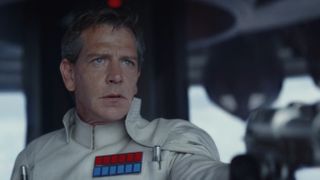
When the ambitious director looks up to see the Death Star’s superlaser in orbit – the very project he presided over – it’s a chilling sight. And as Tarkin’s impassive: “You may fire when ready,” spells his inferior’s doom, it’s also a subtle example of foreshadowing. Just like the dying minutes of A New Hope, the grand moff’s orders are moments too late, the plans that will ultimately destroy the superweapon have already been transmitted. You can even spot the green superlaser’s reflection in Krennic’s eye as he looks up at his creation one last time.
News that Darth Vader would return in Rogue One sent fans into a frenzy. Technological limitations – particularly during A New Hope – meant that we never quite got to witness a fully realized Darth Vader on screen in the Original Trilogy. This was largely mitigated thanks to Ralph McQuarrie’s stunning visual design, Dave Prowse’s powerful physical performance and a combination of James Earl Jones’ menacing vocals and Ben Burtt’s iconic sound design. But an ever-expanding pool of novels and comics teased fans with tales of one of the most powerful Sith Lords of all time, something the prequel’s fast-paced duels and magical special effects only perpetuated.
We’d have to wait until Rogue One for that Darth Vader to appear on the big screen and it was worth the wait. The Dark Lord was finally unleashed at the end of the movie, carving his way through a squad of rebel troopers like a lightsaber through the belly of a tauntaun. The same alarm heard on the Tantive IV at the beginning of A New Hope, paired with low lighting and a jammed door makes for a nail-biting sequence that wouldn’t be out of place in a slasher movie as the rebels scramble to get the plans safely onto the aforementioned blockade runner.
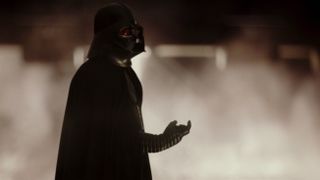
Although he has precious few lines of dialogue, Vader’s voice deserves a mention too. While the de-aging of Earl Jones’ voice in Obi-Wan Kenobi was a most impressive feat, the veteran actor’s performance in Rogue One reaches menacing new heights thanks to the rich timbre and grit of his matured vocals. The villain never overstays his welcome either, leaving you wanting more. Darth Vader in Rogue One is a prime example of a classic Star Wars character done right and the movie’s all the better for his inclusion.
Rogue One does an excellent job of retaining the Original Trilogy’s overall vibe, while introducing new vehicles, characters and locations. Death troopers, U-wings, Scarif and more could have all existed in George Lucas’ original vision. It’s also one of the most cinematic Star Wars movies. The Star Destroyer hovering over Jedha City is a striking concept that conveys the immense size of the capitol ships in a way we’ve never seen before. And the Death Star’s curious portrayal could be interpreted as a visual metaphor. Just prior to destroying Jedha City it causes a visually arresting solar eclipse and as it looms above Scarif it appears to sit amidst the sky’s beautiful blue hues, godlike in both instances.

Sci-fi rarely holds up to scrutiny, so it’s usually best to gloss over the science and enjoy the fiction. And yet the Death Star’s exhaust port was such a glaring – and convenient – omission from the space station’s designers, it was a source of amusement for casual viewers and diehard fans alike for nearly 40 years. Disney could have made light of the womp-rat-sized plot hole for a cheap laugh or filled it in with a passing comment, but instead, Rogue One’s entire plot is dedicated to fixing A New Hope’s narrative. And it’s a damn good one.
At a time when the fandom is questioning how much Disney is able to grasp a galaxy far, far away, let it be known that Rogue One gets Star Wars. It’s a microcosm of everything the Original Trilogy stands for. It’s about an overconfident dictatorship that considers altruism a weakness and underestimates the power of hope.
Krennic’s mistakes will be repeated by his superior Grand Moff Tarkin and later the Emperor himself. And yet, it’s in no way a retelling of the Original Trilogy (a burden the good but unimaginative The Force Awakens must bear). Rogue One’s genius is that it slots neatly behind the Original Trilogy, complementing the source material, while simultaneously bringing a few fresh ideas to the table. And just like A New Hope, its simple David and Goliath narrative is also something casual viewers can get behind.
Andor – Star Wars’ latest series on Disney+ – is being lauded as a gritty noir thriller, which isn’t surprising given the Rogue One source material. It’s the most grown-up movie in the series: Saw Gerrera’s band of resistance fighters are extremists, the Death Star’s destructive power is witnessed at ground level and a crying toddler gets caught in the middle of a firefight for goodness sake. There’s a visceral weight to the series’ oftentimes floaty gunplay too – especially when concerning Baze Malbus’ repeating canon – and that’s before you consider not a single member of Rogue One made it off Scarif alive. Check out our Andor streaming guide to find out how to watch it online yourself.
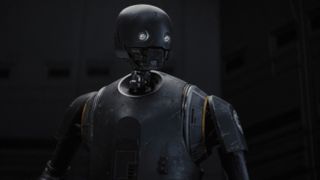
The tragic ending was met with much fanfare. But although each of the main protagonists perishing is certainly new ground for Star Wars – and may never be repeated – the bittersweet conclusion is similar in tone to that of The Empire Strikes Back and Revenge of the Sith.
Star Wars has always been about facing the insurmountable and not giving up, which is why Rogue One ends on a perfect note. The Empire’s might comes out on top and the Rebels are forced to make big sacrifices, but a small win provides a sliver of hope. And as Jyn says herself: “Rebellions are built on Hope.”
And yet, the film isn’t all doom and gloom. Chirrut Îmwe and Baze Malbus’ interactions are delightful and reprogrammed imperial security droid K2SO (Alan Tudyk) provides great comic relief. The droid’s literal dialogue makes for genuine laugh-out-loud moments, but at a time when action flicks stuffed with stilted humor are all the rage, K2SO never belittles the immense stakes.

It’s hardly surprising that there’s some sexual tension between Jyn and Cassian – throughout the course of the movie they go through a heck of a lot together – but Rogue One manages not to sully the characters’ final moment by shoehorning in a generic love story at the last minute. You only have to look no further than The Rise of Skywalker and the curious phenomenon that is ‘Reylo’ to witness this trope at its yawn-inducing best. I guess audiences simply weren’t intelligent enough to grasp Kylo’s redemption without a quick snog. (Ah, yes, he’s a goody again… who gave a dollop of bantha poo about Leia and Han anyway?)
Sure, there’s a moment just after Krennic is shot where Jyn and Cassian look longingly into each other’s eyes, but ultimately their romantic status is left to the viewer’s discretion. Jump to their final moments on Scarif and the pair simply hold hands before sharing a final embrace as the blast wave engulfs them. It’s a moment that stands as one of the most emotive scenes in Star Wars history.
Rogue One’s only shortcomings are a relatively slow start and a CGI cameos – Grand Moff Tarkin that’s situated right up uncanny valley, although not nearly as far as the final scene’s Princess Leia. When we live in a world where Disney is accused of ruining the Skywalker Saga, Rogue One’s biggest compliment is that – knowing everything that preceded that famous opening crawl from 1977 – it changes the way A New Hope is viewed, and for the better.
If you want to know what happens leading up to or after the events of Rogue One our guide to Star Wars movies in chronological order is a good place to start. And if you want access to all the Star Wars movies, check out Disney+.
Join our Space Forums to keep talking space on the latest missions, night sky and more! And if you have a news tip, correction or comment, let us know at: community@space.com.
Get the Space.com Newsletter
Breaking space news, the latest updates on rocket launches, skywatching events and more!
Mike is a freelance writer for Space.com with over ten years experience. He also serves as Deputy Editor for N-Photo: The Nikon Magazine. As you might expect, he's an avid photographer, but he's also a bit of a sci-fi buff so you're just as likely to find him reviewing Star Wars Lego as the latest cameras.
